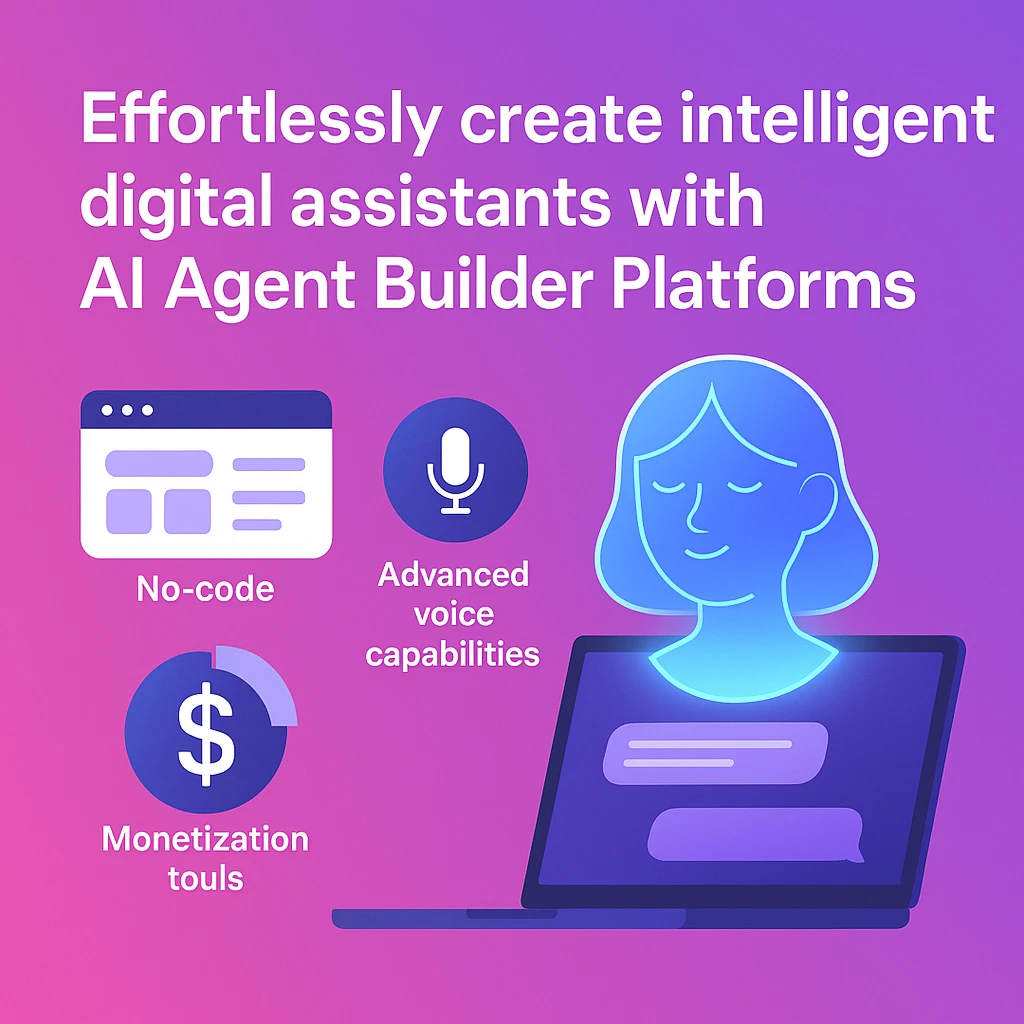“Effortlessly create intelligent digital assistants with AI Agent Builder Platforms, offering intuitive no-code interfaces, advanced voice capabilities, and monetization tools for creators and businesses.”
The world is buzzing with talk about artificial intelligence. Just a few years ago, the idea of a “chatbot” was the peak of automated interaction. It was a simple tool, a glorified FAQ page that could answer basic questions with pre-programmed responses. But technology waits for no one. We’ve moved far beyond that. Today, we’re talking about AI agents—sophisticated, intelligent, and incredibly capable digital entities. These are not your old-school chatbots. These are AI-powered partners designed to understand, learn, and interact in ways that feel remarkably human.
This shift has given rise to a new generation of tools: AI agent builder platforms. These platforms are the workshops where businesses, creators, and educators can forge their custom AI agents without needing a degree in computer science. They are democratizing access to powerful technology, allowing anyone with an idea to bring an AI assistant to life.
But with so many options popping up, how do you choose the right one? What separates a compelling platform from a basic tool? It comes down to the features. The correct features can mean the difference between creating a clunky, frustrating bot and a smooth, intelligent agent that adds real value. This article will walk you through the ten most important features to look for in an AI agent builder. We’ll explore what they are, why they matter, and how they empower you to build something special.
1. An Intuitive No-Code or Low-Code Interface
First, the best tools are the ones you can use. The most groundbreaking AI technology is useless if it’s locked behind a wall of complex code that only a few developers can understand. This is why a no-code or low-code interface is arguably the most critical feature of a modern AI agent builder platform.
What It Is
A no-code interface means you can build, customize, and deploy an AI agent using a visual editor. Think of it like building with LEGOs. You drag, drop, and connect different blocks to create a conversation flow, define the agent’s knowledge, and set up its behaviors. You don’t write a single line of code. Everything is handled through graphical menus, buttons, and visual workflows. A similar low-code interface allows developers to add custom code for more advanced or specific functionalities, providing the best of both worlds.
Why It Matters
This feature single-handedly opens the door to innovation for millions of people. Entrepreneurs, teachers, artists, small business owners, and subject-matter experts—people who know their field inside and out but aren’t programmers—can now build their own AI tools. It dramatically reduces the time and cost of development. You no longer need to hire an expensive team of AI engineers to get your project off the ground. Instead, you can have a working prototype of your agent up and running in a matter of hours, not months.
A Practical Example
Imagine a history teacher who wants to create an AI agent that acts as a “living history” figure, like Albert Einstein or Marie Curie, for her students. With a no-code platform, she could:
- Upload documents, articles, and biographies about the historical figure to create a knowledge base.
- Use a simple visual editor to design how the “AI Einstein” should introduce himself.
- Set up rules for how the agent should answer questions about relativity, his life, and his scientific discoveries.
- Deploy this agent on the class website for students to interact with.
She could accomplish all of this in an afternoon without any programming knowledge. This is the power of a user-friendly interface; it puts the ability to create directly into the hands of experts, transforming the process from a technical challenge into a creative one.
2. Advanced Customization and Personalization
An AI agent is more than just a source of information; it represents your brand, project, or personality. A generic, one-size-fits-all agent feels impersonal and fails to connect with the user. That’s why deep customization is a non-negotiable feature for top-tier AI agent builder platforms.
What It Is
Advanced customization goes far beyond just naming your agent. It’s about controlling every aspect of its identity to ensure it aligns perfectly with your goals. This includes:
- Personality and Tone: Is your agent formal, professional, or witty and casual? You should be able to define its persona, communication style, and sense of humor.
- Response Style: Can the agent give short, direct answers, or should it provide detailed, narrative explanations? Can it use emojis or stick to plain text?
- Avatar and Visuals: The ability to upload a custom avatar or choose from a library helps give your agent a face, making the interaction feel more personal.
- Behavioral Rules: You should be able to set specific guidelines. For example, you might instruct your agent never to offer financial advice or always to end a conversation with a positive affirmation.
Why It Matters
Brand consistency is key. Your AI agent is an extension of your brand’s voice. An agent for a children’s educational platform should sound encouraging, patient, and fun. In contrast, an agent for a legal tech company needs to be precise, formal, and authoritative. Without customization, you risk a disconnect between your brand identity and the user’s experience with your agent. Personalization makes the interaction more engaging, memorable, and trustworthy.
A Practical Example
Consider a fitness coach who wants to build an AI agent to motivate clients. Through advanced customization, she can:
- Name the agent “Coach Leo.”
- Give it an energetic, tough, but fair, and highly motivational personality. She can instruct it to use encouraging phrases like “You’ve got this!” and “Push through the burn!”
- Upload a custom avatar of a friendly but strong lion mascot.
- Set a rule that the agent always asks about the user’s workout at the beginning of a conversation to create a sense of accountability.
This level of detail transforms the agent from a simple Q&A bot into a faithful digital coaching companion that reflects her unique coaching style. It’s no longer just an “AI”; it’s “Coach Leo.” That’s the difference customization makes.
3. Powerful Voice Capabilities
Text is great, but voice is the future of human-computer interaction. We are moving toward a world where speaking to our devices is as natural as talking to someone. Therefore, any serious AI agent builder platform must offer robust voice AI capabilities. This primary feature separates modern AI agents from older AI chatbot alternatives.
What It Is
Powerful voice capabilities involve more than just a robotic voice reading text aloud. It’s a complete suite of audio technologies working in harmony:
- High-Quality Text-to-Speech (TTS): This technology converts written text into spoken words. The best platforms offer various incredibly natural-sounding voices, not just one or two robotic options. This includes different genders, ages, accents, and languages.
- Clonable and Custom Voices: The ability to clone your voice or create a unique brand voice for your agent is a game-changer for personalization.
- Emotional Intonation: Advanced TTS can add emotional nuance to speech. Depending on the conversation context, the agent’s voice can sound excited, empathetic, calm, or serious.
- Accurate Speech-to-Text (STT): This is the flip side—the agent’s ability to accurately understand what the user is saying, even with background noise or different accents.
Why It Matters
Voice makes interaction more natural, intuitive, and accessible. It allows for hands-free use, essential for driving, cooking, or having a full hand. It’s also a critical feature for accessibility, making information available to users with visual impairments or reading difficulties. Furthermore, the human voice carries emotional weight. A well-crafted voice AI agent can build a much stronger connection with a user than a text-only interface ever could.
A Practical Example
Let’s think about a mental wellness company creating an AI agent for guided meditation. With powerful voice features, they can:
- Select a voice that is exceptionally calm, soft, and soothing.
- Use intonation controls to ensure the agent speaks slowly and deliberately during meditation exercises, with gentle pauses for reflection.
- Offer users the choice between a few calming voices to find the one they connect with most.
- The agent can understand spoken responses from the user, such as “I’m ready to begin” or “Can you repeat that?”
In this scenario, the voice isn’t just a feature but the entire experience. The voice’s quality and naturalness directly determine the product’s effectiveness. This demonstrates why investing in a platform with superior voice capabilities is essential for creating truly immersive and impactful AI agents.
4. Deep Knowledge Integration
An AI agent is only as intelligent as the information it accesses. A generic agent that pulls from the entire internet can answer trivia questions , but can’t answer specific questions about your business, your course, or your products. This is where deep knowledge integration comes in. It’s the process of giving your agent its specialized brain.
What It Is
Deep knowledge integration allows the platform to ingest and understand your proprietary data. The best platforms make this process incredibly simple. You should be able to “feed” your agent information from various sources, such as:
- Documents (PDFs, Word docs)
- Website content (by simply providing a URL)
- Spreadsheets and databases
- Transcripts from videos or podcasts
- Plain text files
A powerful platform doesn’t just store this information; it uses advanced AI models to understand the data’s context, relationships, and nuances. This allows the agent to provide accurate, contextually aware answers instead of just spitting back chunks of text.
Why It Matters
This feature is what makes your agent genuinely helpful. It transforms it from a generalist into a specialist. Your AI agent becomes a true expert in your specific domain. This ensures that users receive accurate, reliable, and relevant information they can’t find with a simple Google search. It also protects your intellectual property, as the agent only draws from the knowledge base you provide, preventing it from sharing incorrect or unauthorized information.
A Practical Example
A real estate company builds an AI agent to help potential buyers. They use the platform’s knowledge integration feature to upload:
- PDF brochures for all of their current listings.
- A spreadsheet with details on each property (price, square footage, number of bedrooms).
- Documents explaining the home-buying process and mortgage options.
- A link to their blog contains articles on local neighborhoods and schools.
Now, a user can ask questions like, “Do you have any three-bedroom houses in the Northwood school district for under $500,000?” or “What are the property taxes for the listing on 123 Maple Street?” The AI agent can instantly synthesize information from all these sources to provide an accurate answer. It has become an expert real estate assistant, available 24/7.
5. Seamless Third-Party Integrations
An AI agent shouldn’t be an island. To be truly effective, especially in a business context, it must communicate and interact with the other software tools you already use. This is where integrations come in. They are the bridges that connect your AI agent to the rest of your digital ecosystem, turning it from a conversational tool into a hub for AI-powered automation.
What It Is
Seamless third-party integrations refer to the platform’s ability to connect to other applications and services through APIs (Application Programming Interfaces). An API is a set of rules that allows different software programs to talk to each other. A top-tier AI agent builder should have a library of pre-built integrations for popular tools and also provide the flexibility to create custom connections. Common integrations include:
- CRMs: Salesforce, HubSpot
- Calendars: Google Calendar, Outlook Calendar
- E-commerce Platforms: Shopify, WooCommerce
- Communication Tools: Slack, Twilio
- Payment Gateways: Stripe, PayPal
Why It Matters
Integrations are what allow your AI agent to do things. Without them, an agent can only talk. With them, it can take action. It can schedule appointments, process orders, update customer records, send notifications, and perform countless other tasks. This automates workflows, saves your human team an incredible amount of time, and provides a much more efficient and satisfying experience for the user. The agent becomes a functional part of your operations, not just an add-on.
A Practical Example
Imagine a customer support agent for an online store. A customer starts a conversation and says, “I’d like to return the blue sweater I ordered last week.”
- Without integrations, the agent could only say, “Please email our support team at [email protected] to process a return.”
- With integrations, the agent’s response is entirely different. It can say, “I can help with that. I’ve found your order from last week. To start the return process for the blue sweater, please confirm your shipping address.”
Behind the scenes, the agent integrated the Shopify platform to look up the customer’s order history. Once the customer confirms, the agent can use another integration with a shipping service to automatically generate a return label and email it to the customer. This entire process is automated, instant, and frictionless for the customer.
6. Robust Analytics and Performance Tracking
Building an AI agent is not a “set it and forget it” task. You must understand how people use it to ensure your agent is practical, helpful, and provides a positive user experience. This is impossible without a powerful analytics dashboard. Data is the key to iteration and improvement.
What It Is
Robust analytics provide you with a comprehensive overview of your agent’s performance. The control panel shows you what’s happening under the hood. Key metrics to look for include:
- Conversation Volume: How many conversations does your agent have per day, week, or month?
- User Engagement: How long do conversations last? How many messages are exchanged on average?
- Most Frequent Questions: What topics are users asking about most often?
- Unanswered Questions: Where is the agent failing? What questions is it unable to answer? This is crucial for identifying knowledge gaps.
- User Satisfaction Ratings: The ability for users to give a “thumbs up” or “thumbs down” to an answer provides direct feedback on its quality.
- Conversation Paths: Visualizing the flow of conversations can help you identify everyday journeys and potential roadblocks for users.
Why It Matters
Analytics provide actionable insights. They replace guesswork with complex data. By understanding what your users are asking, you can refine your agent’s knowledge base to be more helpful. By identifying where conversations fail, you can improve their conversational design. You can see which features are being used and which are being ignored. Analytics create a feedback loop that allows you to continuously improve your agent, making it smarter, more efficient, and more aligned with your users’ needs.
A Practical Example
An online university uses an AI agent to help students with course registration. After a month, the administrator checks the analytics dashboard and discovers a few key things:
- Many questions are about “payment plan options,” but the agent’s knowledge base has very little information on this topic, leading to low satisfaction ratings for those conversations.
- Many students drop off in the middle of the conversation when the agent asks for their student ID number.
- The most popular feature is the ability to ask about course prerequisites.
Based on this data, the administrator takes action. She adds a detailed document about all available payment plans to the agent’s knowledge. She modifies the conversation flow to explain why the student ID is needed before asking for it, reducing the drop-off rate. She also ensures that the information about prerequisites is even more prominent. The analytics dashboard turned user behavior into a clear roadmap for improvement.
7. Scalability and Reliability
When you launch your AI agent, you want to be confident that it can handle success. What happens if your agent is featured in a popular blog post or goes viral on social media? Will it crash under the sudden load of thousands of simultaneous users? A platform’s scalability and reliability are crucial features that determine its readiness for the real world.
What It Is
- Scalability is the platform’s ability to handle a growing number of users and interactions without any degradation in performance. Whether ten users a day or ten thousand users an hour, the agent’s response time and functionality should remain consistent. This is typically achieved through cloud-based infrastructure, which automatically allocates more resources as needed.
- Reliability refers to the platform’s uptime and stability. A reliable platform guarantees that your agent will be online and available for users virtually 100% of the time. This includes having redundant systems and backups in place to prevent outages.
Why It Matters
An agent that is slow, buggy, or frequently offline is worse than no agent. It creates frustration for users and reflects poorly on your brand. If you use the agent for critical business functions like sales or customer support, downtime means lost revenue and a damaged reputation. You need to choose a platform built on a robust infrastructure that you can depend on, especially as your user base grows.
A Practical Example
A creator launches an AI agent that offers personalized storytelling experiences for children. For the first few months, it has had a steady base of a few hundred users. Then, a major parenting influencer features the agent in a video. Overnight, traffic explodes.
- On an unscalable platform: The servers would be overwhelmed. The agent would become incredibly slow, time out, or crash altogether. New users would have a terrible first experience, and the creator would miss a massive opportunity for growth.
- On a scalable platform: The cloud infrastructure would automatically detect the spike in traffic and allocate more processing power. Every new user would have the same fast, seamless experience as the first user. The agent would perform flawlessly, capturing thousands of new, happy users.
Scalability isn’t just a technical detail; it’s a prerequisite for growth and success.
8. A Thriving Marketplace and Community
Building an AI agent can sometimes feel like a solitary endeavor, but it doesn’t have to be. The very best platforms understand the power of collaboration and community. They foster an ecosystem where users can share their creations, learn from each other, and build upon the work of others. An AI agent marketplace is the hub of this ecosystem.
What It Is
An AI agent marketplace is a central repository where creators can publish, share, discover, and sell AI agents, templates, and specialized skills. It’s like an app store, but for AI agents.
- For builders: It’s a place to find inspiration. You can see what others are creating, import a template to get a head start on your project, or purchase a pre-built agent that already does 90% of what you need.
- For creators: It’s a distribution channel and a potential source of revenue. If you build a fantastic agent for a specific niche (e.g., a real estate law tutor), you can publish it on the marketplace for others to use or buy.
The community aspect often extends to forums, knowledge bases, and support channels where users can ask questions, share tips, and collaborate.
Why It Matters
A marketplace and community drastically accelerate the development process. You don’t always have to reinvent the wheel. If you need an agent to handle HR onboarding, someone has already built an excellent template for it. This saves time and effort and fosters a culture of innovation. Seeing what others are building can spark new ideas and push the boundaries of what you thought was possible. For those looking to monetize their expertise, the marketplace provides a direct path to a global audience.
A Practical Example
A small accounting firm wants to easily build AI agents to help clients with common tax questions. Instead of starting from scratch, the firm’s manager browses the platform’s marketplace. She finds a highly-rated “Small Business Tax Agent” template created by a certified public accountant. She purchases the template, which comes pre-loaded with knowledge about standard deductions, tax deadlines, and filing procedures. All she has to do is add specific information about her firm’s services and branding. In a couple of hours, she has a powerful, expert agent ready to deploy—a task that would have taken weeks to build from the ground up.
9. Strong Security and Data Privacy
In an age of constant data breaches and growing privacy concerns, security is not optional but a fundamental requirement. When users interact with your AI agent, they entrust you with their data, whether it’s their email address, personal questions, or business information. A breach of that trust can be catastrophic.
What It Is
Strong security and data privacy encompass a range of technical and policy-based measures designed to protect you and your users. This includes:
- Data Encryption: All data, both when it’s being transmitted (in transit) and when it’s being stored (at rest), should be encrypted so that it’s unreadable to unauthorized parties.
- Compliance with Regulations: The platform must comply with major data protection laws, such as GDPR (General Data Protection Regulation) in Europe and CCPA (California Consumer Privacy Act). If you’re in a specific industry, you should comply with standards like HIPAA for healthcare.
- User Authentication: Secure user login and access control methods to ensure only authorized individuals can manage the AI agents.
- Clear Privacy Policies: The platform should be transparent about what data it collects, how it’s used, and how it’s protected.
Why It Matters
The consequences of poor security are severe. They include legal penalties, hefty fines, and, perhaps most damagingly, a complete loss of user trust. A reputation for being insecure is formidable to recover from. Choosing a platform that prioritizes security is essential to responsible AI development. It shows your users that you value their privacy and are committed to protecting their information.
A Practical Example
A financial advisory firm wants to create an AI agent to help clients with basic budget planning. During the conversation, the agent might ask about the user’s income, expenses, and savings goals. This is highly sensitive personal financial information. The firm must choose an AI agent builder platform with ironclad security. The platform must demonstrate end-to-end encryption, comply with financial data regulations, and have robust measures to prevent unauthorized access to the conversation logs. This allows the firm to confidently offer the tool to its clients, knowing their sensitive data is secure.
10. Monetization and E-commerce Tools
For many creators and businesses, an AI agent is not just a tool for engagement or support; it’s a product. The ability to directly generate revenue from your AI agent can turn it from a cost center into a powerful profit center. This is where built-in monetization tools become a critical feature.
What It Is
Monetization tools are features integrated directly into the platform that allow you to charge users for access to your AI agent or the content it provides. This can take several forms:
- Subscription Models: Users pay a recurring monthly or annual fee for ongoing access to the agent.
- One-Time Payments: Users pay a single fee to unlock the agent or a specific piece of premium content.
- Pay-per-Use: A model where users are charged based on the number of queries or time spent with the agent.
- E-commerce Integration: The ability to sell digital products (like e-books, courses, or guides) or even physical goods directly through the conversation.
Why It Matters
Monetization opens up entirely new business models for AI for businesses and creators. An expert can package their knowledge into a subscription-based AI coaching agent. An artist can create an AI agent that generates unique art prompts and sells access to them. An educator can build a premium AI tutor that helps students study for an exam and charge a one-time fee. This allows you to directly profit from your expertise and intellectual property, creating a sustainable revenue stream powered by AI.
A Practical Example
A renowned chef decides to create an AI “Sous Chef” agent. She uses a platform with strong monetization features to set up the following model:
- Free Tier: Anyone can ask the agent for basic recipes and cooking tips.
- Premium Subscription ($9.99/month): Subscribers unlock the agent’s full capabilities. They can request personalized meal plans based on their dietary restrictions, receive step-by-step voice-guided instructions while they cook, and access the chef’s exclusive library of advanced recipes.
The agent integrates with Stripe to handle subscription payments securely. This model provides value to free users while creating a compelling reason for them to upgrade, turning the chef’s culinary expertise into a scalable, recurring revenue business.
The Next Generation of AI Agents: Introducing ScaleWise AI
Now that we’ve explored the ten essential features of a top-tier platform, you’re probably wondering where you can find a tool that integrates all of this. We’d like to introduce you to ScaleWise AI.
ScaleWise AI is a leading, free platform and marketplace designed to empower businesses, creators, and educators to build powerful voice AI agents without coding. It was built from the ground up with the understanding that the future of AI is not in simple text-based chatbots, but in intelligent, voice-enabled agents that can share knowledge, train teams, educate audiences, and sell content 24/7.
Let’s see how ScaleWise AI aligns with the critical features we’ve discussed:
- Intuitive and No-Code: ScaleWise AI offers a simple, visual interface that lets you build AI agents easily, regardless of your technical background.
- Deep Customization & Voice Power: It specializes in voice AI agents, allowing you to choose from a library of natural-sounding voices or create a custom voice to match your brand perfectly. You control the personality and expertise.
- Expert Knowledge: You can effortlessly upload your documents, website links, and other data to create an agent that is a true expert in your specific domain.
- Marketplace and Monetization: ScaleWise AI isn’t just a builder; it’s a thriving AI agent marketplace. You can publish your agents for others to discover, and more importantly, you can use built-in tools to sell exclusive content or offer premium access, effortlessly creating new revenue streams.
- Beyond Chatbots: ScaleWise sets itself apart from typical AI chatbot alternatives by focusing on high-value interactions. This platform allows you to create an AI sales coach who trains your team, an AI educator who tutors students, or an AI concierge who sells access to your exclusive digital products.
If you’re looking for a powerful, easy-to-use AI Agent Builder Platform focused on the future of voice-first interaction, ScaleWise AI is the place to start. It provides all the tools you need to move beyond simple automation and create knowledgeable AI partners.
Frequently Asked Questions (FAQs)
1. What is the main difference between an AI agent and a traditional chatbot?
The primary difference lies in their intelligence and capability. A traditional chatbot typically follows a rigid, pre-programmed script or decision tree. It can only respond to specific keywords and commands it has been explicitly told to recognize. An AI agent, on the other hand, is powered by large language models (LLMs) and generative AI. This allows it to understand context, handle complex queries, learn from conversations, and generate dynamic, human-like responses. Furthermore, AI agents, especially those built on platforms like ScaleWise AI, can integrate with other systems to perform tasks, not just provide information.
2. Can I be a programmer to use an AI agent builder platform?
Not! The key feature of modern platforms, and a core principle of ScaleWise AI, is the no-code AI builder interface. These platforms are designed for business owners, educators, marketers, and creators. You use visual tools, drag-and-drop editors, and simple forms to build your agent, with no coding required.
3. How can AI agents be used in education?
The possibilities for AI for educators are immense. An AI agent can be a 24/7 tutor, answering student questions about coursework. It can be a study partner that quizzes students to help them prepare for exams. Teachers can create agents that simulate historical figures for interactive history lessons or act as a guide for complex science experiments. It’s a powerful tool for providing personalized learning support at scale.
4. Can I safely provide my business data to an AI agent builder platform?
This is a valid and essential concern. It’s crucial to choose a platform that prioritizes security. Reputable platforms use strong encryption for all data in transit and at rest. They comply with major data privacy regulations like GDPR and provide clear policies on how your data is used. Always review a platform’s security and privacy documentation before uploading sensitive information.
5. How can I make money with an AI agent?
There are several models for monetizing your AI agent. Platforms with built-in monetization tools allow you to:
- Sell Subscriptions: Charge a recurring fee for ongoing access to your agent’s premium features or knowledge.
- Sell Exclusive Content: Use the agent as a gatekeeper for valuable digital content, such as e-books, research reports, or online courses. Users can purchase and access the content directly through the agent.
- Offer a Service: The agent itself can be the service. For example, an AI agent that provides personalized financial coaching or career advice could be offered as a paid product on an AI agent marketplace.





